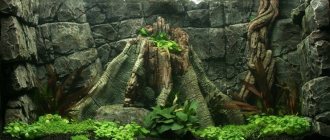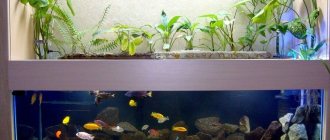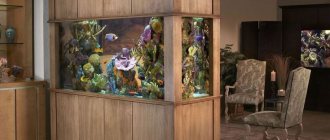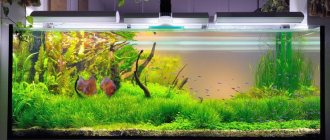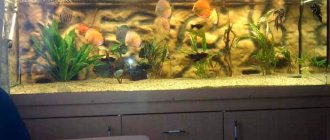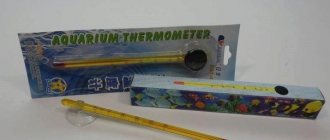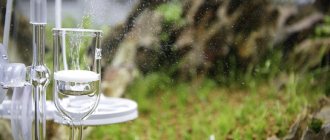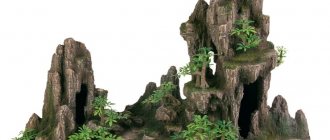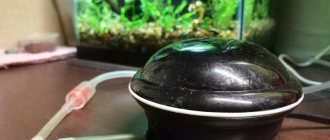4.9
(27)
When starting an aquarium, we want to choose beautiful fish for it that would decorate our home pond. Of course, you can buy different representatives of underwater fauna, but species aquariums always look especially interesting, where only one family of fish swims, and at the same time the design is designed according to the natural needs of these animals. For example, you can create your own cichlid tank, in which beautiful fish native to Africa or South America will swim (depending on the tastes of the aquarist). But in order for it to really please the owner, you need to know how a biotope aquarium of this type is created.
What is a cichlid
A cichlid tank is a species aquarium in which conditions for cichlids are created that are as close as possible to natural ones. As a rule, a cichlid tank is equipped in accordance with the distribution area of a particular cichlid species – African. Asian, South American, Madagascar.
Plants from a given region are selected in strict accordance. A cichlid monitor is created to observe the behavior and reproduction of cichlids. Often fish of other species are added to the aquarium, stimulating the characteristic behavior of cichlids, the manifestation of their natural characteristics - territoriality, caring for offspring.
The character of cichlids is quite complex - they do not get along well with their neighbors and compete for territory with their relatives, spoiling the design by digging shelters and tearing out plants. Therefore, creating a cichlid fish that takes into account all the characteristics of cichlids is a difficult but interesting task.
Cichlid diseases
Cichlids have strong immunity, but improper maintenance leads to diseases in the aquarium. The causes of non-infectious, bacterial and chemical diseases can be:
- poor quality food;
- malnutrition;
- unsuitable water parameters;
- nitrate poisoning;
- stress.
The infection is introduced into the aquarium:
- new plants;
- through the ground;
- live food;
- new fish.
Common Cichlid Diseases:
- Hexamitosis. Accompanied by enlarged pores in the area of the head and lateral line, lack of appetite and exhaustion of the fish. Treated with metronidazole. In an advanced stage it leads to the death of the pet.
- Ichthyophthiriasis (semolina in fish). The body is covered with a white coating. It is treated with special means. Sometimes quinine hydrochloride is purchased and crushed in proportions of 0.25 g per liter of water.
- African bloat. The disease is accompanied by lethargy and loss of appetite. The fish's body swells and its eyes bulge. The disease lasts 3 days with a fatal outcome. Affects people from Lake Malawi. Treated with an antibiotic.
- Saprolegniosis. Cotton-like growths appear on the body of the fish. The disease is treated with medications containing phenoxyethanol.
Many diseases can be prevented:
- monitoring water quality;
- compliance with the conditions of population density;
- installing the aquarium in a quiet and quiet place;
- quarantine when introducing new fish;
- processing of live food;
- compliance with the composition and norms of nutrition;
- establishing a filtration and aeration system.
What are cichlids
Cichlids are one of the largest families, including more than 1900 species. Of these, about 1,300 have been sufficiently fully studied and systematized. Cichlids or cichlids belong to the class of ray-finned fish, the order of perciformes. The large species diversity attracts aquarists.
Dimensions . Cichlids include fish measuring 2.5 cm that live only in Lake Tanganyika. Tiny neolamprologus live in mollusk shells and are the smallest representatives of cichlids. This family also includes real giants, reaching 1 m. The imperial cichlid lives in the African Lake Tanganyika and is only slightly inferior in size to the giant from South America - the speckled peacock.
Coloring . Among the cichlids there are lilac-raspberry, lemon, turquoise, green, blue, orange, cornflower blue, and red. Many have a very special coloring of scales, making the body of the fish shine like a diamond scattering, for example:
- fairy mother-of-pearl;
- Geophagus mother-of-pearl;
- Akara turquoise.
In some species, the vertical dark stripes characteristic of the family are so pronounced that this is reflected in their name:
- zebra cichlasoma;
- pseudotropheus zebra;
- golden leopard;
- five striped zebra.
Such diversity allows you to create a reservoir filled with a riot of colors and a variety of shapes. Like no other aquarium species, a cichlid can become an unforgettable interior decoration.
Description of cyclides
It is also necessary to understand what kind of cichlids they are. For beginners who love aquarium life, it will be interesting that such fish exist in 1900 species, and they all differ from each other in their beauty. But they are interesting not only for their varied and bright colors, but also for their very unusual behavior.
There are several types of this fish
Among decorative, typically aquarium cichlids, the most common species are:
- discus;
- Oscars;
- angelfish;
- striped parrot;
- julidochromis;
- handsome chromis.
Such fish have a small body, flattened on the sides. But there is also a commercial cichlid fish - tilapia, which can be found on the shelves of fish stores.
General requirements
To take all factors into account as much as possible, aquarists create a geographical cichlid fish tank, in which they select plants and fish from a certain region. The biotope cichlid also looks interesting, in which the characteristic features of the habitat - a lake, a stream - are reproduced with great accuracy. There are general requirements for making a mixed aquarium for different types of cichlids.
Aquarium for cichlids
First of all, you need to select and arrange the aquarium.
Size
The average size of cichlids is about 30 cm, so the volume should be large. It is recommended to proceed on the basis of 1 cm of fish body per 2-3 liters of water.
For 1 cichlid you need at least 50-60 liters.
Cichlids are schooling fish, so this also needs to be taken into account. It is equally important to consider the territorial behavior of cichlids.
In order for the fish not to show their aggressive, quarrelsome nature, they must have enough space for their own space, which other fish will not constantly invade, especially during the breeding season. Taking into account all factors, it is recommended to choose a capacity of at least 120-200 liters.
Form
A significant volume of water requires high strength glass and reliable seams.
Preference should be given to a rectangular aquarium of the “trough” type – with a length of 90-200 cm.
This way the fish will have more free space to swim and have the opportunity to zone the space.
Excessive forms are not welcome - additional corners and protrusions will distort the view, interfere with visibility, and create “dead” zones for free circulation of water. In such “pockets” it is difficult to clean the soil from biological residues, which over time will begin to decompose, releasing toxic substances.
Filtration
Cichlids leave behind a large amount of waste; they love to rummage in the soil, raising turbidity, and tearing off leaves from plants. All this requires a good cleaning. Therefore, filters in cichlids must be powerful with high productivity and several degrees of purification - mechanical, chemical, biological.
Pump and water heater
To circulate water, mix layers and saturate with oxygen, there must be a powerful pump that provides good aeration. To recreate the microclimate of the tropics and subtropics, you need a water heater with temperature control. During the winter months, it will prevent the temperature from dropping too much, leading to the death of the cichlids.
Location and anchoring
To place the cichlid, you should choose a place away from a source of natural light. These types of fish do not like bright sunlight, preferring shade. Away from windows in the aquarium there will be less risk of algae growth.
Last but not least, a strong support is important in the structure of a cichlid. A large-volume aquarium weighs a lot and this requires proper placement, a reliable base, and even distribution of the load.
Cichlid bottom
The requirements for the soil with which the bottom of the cichlid is covered are determined by:
- cichlids love to dig up the soil, therefore, it should be such that the fish do not get hurt and there is no agitation;
- creating a winning background - the color of the soil should emphasize the beauty of the color and shape of cichlids;
- simplicity and ease of cleaning.
As a soil you can choose:
- Snow-white, cream or gray marble chips with a diameter of 1.5-2 mm. The advantage of such bottom covering is safety, absence of turbidity, and creation of a snow-white background for decor and fish. In addition, marble chips slightly increase the water hardness, which is important for cichlids.
- Coarse quartz sand.
- Small rounded pebbles.
- Black basalt with a fraction of 3-6 mm.
- Screening of granite with a fraction of 2-6 mm.
- Crushed stone screening, fraction 2-6.
It is enough to fill such soil with a layer of 5 cm. The larger the soil, the thicker the layer can be. It will be convenient to bury pots with plants in it. When choosing a soil fraction, it should be taken into account that some types of cichlids like to roll pebbles in their mouths - too large particles can damage the oral cavity. So aquarists choose the soil in accordance with the size of the fish and the type of planned landscape.
Decoration
Cichlids need grottoes, rock slides and driftwood. They are not only decorative elements that allow you to create a beautiful landscape. Fish love to hide and rest in grottoes. Some species of cichlids attach eggs to the roof or walls of grottoes.
With the help of stone slides, you can zone the space, dividing the territories of individual pairs of fish. But when creating a landscape, you must adhere to safety considerations:
- Large stones must be secured so that the fish do not overturn them to the bottom or crush each other. Silicone is used as a “backing” to make the slide stable and not break the glass.
- The entrance to the grotto should be quite spacious so that the fish do not get stuck.
- The edges of the decorative elements should not be sharp so that the cichlids do not get hurt.
You need to decorate the bottom of the aquarium so that there is free space for swimming - do not get too carried away with decoration. All elements must be harmoniously combined.
The driftwood used in the design of the cichlid fish will not only naturally fit into the landscape of the underwater world, but will also improve the characteristics of the water - make it softer and saturate it with natural tannins, which have antibacterial properties. You will have to constantly “rework” the decorations, since cichlids can move, drop and bury some elements.
Plants for cichlids
Most cichlid aquarists eschew vegetation in favor of artificial plants or rocky moonscapes. But you shouldn’t give up an additional biological filter and oxygen source.
Selection rules . When choosing plants for your cichlid garden, you should give preference to unpretentious, fast-growing crops with rigid stems and dense leaves. Such plants should not require a nutrient substrate, recover quickly and comply with the characteristics of the water. To insure the root system from damage, plants can be planted in pots that are secured in the ground with weights.
Which ones are suitable?
The optimal choice for a cichlid is:
- hygrophila;
- nymphs;
- gymnocoronis;
- monosolenium;
- Vallisneria;
- cryptocorynes;
- Brazilian pinnate;
- Echinodorus;
- limnophila ambulia;
- aponogeton ulvoides;
- ferns.
Floating vegetation is not of interest to cichlids, so various types of duckweed, riccia, cladophora, and pistia will create the diffused light so beloved by cichlids and decorate the aquarium.
Planting rules. Tall plants are planted along the walls of the aquarium, plants in the middle ground are arranged in separate picturesque groups. Fluffy green mosses are used to decorate driftwood and stones. Many aquarists note that if plants are not located on the “paths” of cichlids, then they are not interested in them. Experience and observation of the habits of cichlids will help you position the plants correctly.
Choosing an aquarium
Having your own cichlid is very interesting, but it is important that this “home” for the fish is correctly selected to suit their character and habits. A classic rectangular container is ideal, but you want it to be wide rather than tall.
This is explained by the fact that cichlids are territorial fish, and the larger the bottom area, the more spacious these animals will feel. Each individual or pair will find a secluded corner for themselves where no one will disturb them.
As for the displacement, it directly depends on the size of the school and the varieties of fish. If these are small species like yellow, apistogramma, etc., then an aquarium of 200 liters will be enough. If you want to plant larger specimens like aulonocara or angelfish, then you will need to allocate at least 50 liters for one fish. If we talk about large cichlids, then, of course, they need more volume. For example, severums (25-30 cm) require 150 liters per pair, discus - about 400 liters, flower horn (20-40 cm) - at least 100-150 liters for one fish.
Zoning
To create “privacy” for the inhabitants of the cichlid, to delimit their territories and avoid conflicts, you need to properly divide the landscape into separate areas using screens of plants and decorative elements.
You should observe where each couple prefers to relax, in which sector of the aquarium they most often dig, and place there half a coconut shell, a fragment of a ceramic pot or a grotto under the cover of a bush of vegetation.
Zoning will have to be improved frequently until the cichlids are satisfied with the division of the territory. Their reaction will be noticeable in their behavior and relationships with neighbors.
Feeding
The diet of cichlids varies quite a lot depending on the specific species. For herbivores, it is preferable to feed chopped lettuce, spinach, dandelion, cucumbers, carrots, zucchini, and spirulina tablets.
Predators need protein food - finely chopped squid, fish, beef, shrimp, live food. You also need to remember that a pair of African cichlids may completely refuse to eat during the incubation period of carrying eggs in the mouth (from 15 to 40 days).
When keeping all cichlids, it is better to adhere to the rule of the golden mean - the fish diet should be complete, of high quality and properly balanced. For predators, the content of by-products (meat, seafood) should be minimal; it is better to give preference to live (bloodworms, Artemia nauplii, cortera) and ready-made industrial feeds.
The Mbuna group of cichlids belongs to phytophages and in their diet up to 70% of food should be of plant origin and only 30% protein. It is most profitable to grow duckweed as a live feed, as it reproduces very quickly.
All cichlids are not picky and eat dry daphnia and gammarus well.
Twice a week you can feed them a homemade delicacy. To do this, take a frozen bovine or beef heart, cut off the fat and films from it, finely chop or grate it and freeze it in small portions.
Conditions for keeping cichlids
Each species of cichlid requires specific characteristics and habitat parameters. They should replicate natural conditions as much as possible.
African cichlids
Most species of African cichlids live in 2 lakes formed at the site of tectonic faults in the earth's crust - Malawi (Nyasa) and Tanganyika. They are characterized by stability of indicators. In the lakes, up to 90% of the inhabitants are represented by different species of cichlids and most of them are endemic. This means that they are very sensitive to changes in their environment, and for their comfort the following parameters must be strictly observed:
- temperature – +24-27°C;
- hardness – 10-18 dGH (for inhabitants of Lake Nyasa) and 10-25 dGH (for cichlids of Lake Tanganyika);
- pH – 7.0-8.0 (for the inhabitants of Lake Nyasa) and 8.0-9.0 (for the cichlids of Lake Tanganyika).
African cichlids require weekly water changes of up to 30%.
American cichlids
American cichlids have a completely different habitat from their African relatives. Most species live in tributaries of the Amazon, where the water is the color of tea leaves thanks to a thick layer of fallen leaves and tree branches. This is soft, slightly alkaline and well-heated water with a slow flow.
Cichlids are found in clear, fast-flowing streams with cool water, as well as in floodplains where fresh and salt water mix. In order to create comfortable conditions, you need to know what kind of water representatives of a particular species are accustomed to:
- temperature regime – +23-25°C is suitable for most species, but for discus fish it is comfortable +30-32°C;
- hardness – no higher than 5-15 dGH;
- pH – 4.0-8.0.
Good filtration and aeration are necessary. To create “black” water, use well-dried leaves or a filter with peat filler.
Priming
The substrate matters a lot. When choosing it, you need to start from the size of the pets. For medium types, sand with a fraction of 3-5 mm is suitable. It looks good, is easy to clean and does not sour. The optimal layer is about 6-8 cm. This will allow you to achieve optimal proportions, and in addition, will make it possible to plant some types of plants.
For larger cichlids, coarse soil is suitable, namely pebbles, quartz, etc. Basalt can also be used, but it must be stirred periodically as gaseous substances can accumulate in it.
Nuances of design taking into account spawning
Cichlids are also varied in their spawning habits, as well as in variations in shape and color. For example, some species of cichlids prefer to glue their clutches to the back side of large plant leaves, others make holes in the ground, clearing the clutch site to the very bottom of the aquarium, and still others spawn on flat stones. All these features should be taken into account when arranging a cichlid fish.
To avoid difficulties when keeping several species of cichlids together, you should place a couple for spawning in a special aquarium - a spawning tank.
Cichlids are one of the most beautiful, interesting and diverse families. Arranging a “home” for these fish requires attention, a balanced approach and careful compliance with the conditions of detention. Therefore, it is difficult to make a cichlid for a beginner. But this is a huge field for creativity, practical application of knowledge and enjoyment of the result of work.
Launch
Fine sand is placed in the cichlid tank with African fish, and plants are planted densely. But there should also be enough space for swimming. Mounds of stones, caves and pots are used as decoration. In the right conditions, the fish will be able to spawn and thrive.
American cichlids have a more conflicting nature. These pets can do without plants, but if you choose live plants, it is better to opt for more hardy ones such as anubias and Java moss. Flat stones on which fish can lay eggs, and shelters in the form of caves and shells are suitable for decoration.
An aquarium with Amazons requires thickets of plants with free space for the fish to move around. Cryptocoryne and Echinodorus are suitable, since angelfish usually spawn on plant leaves. For other inhabitants you will need caves and stones.
Return to content
